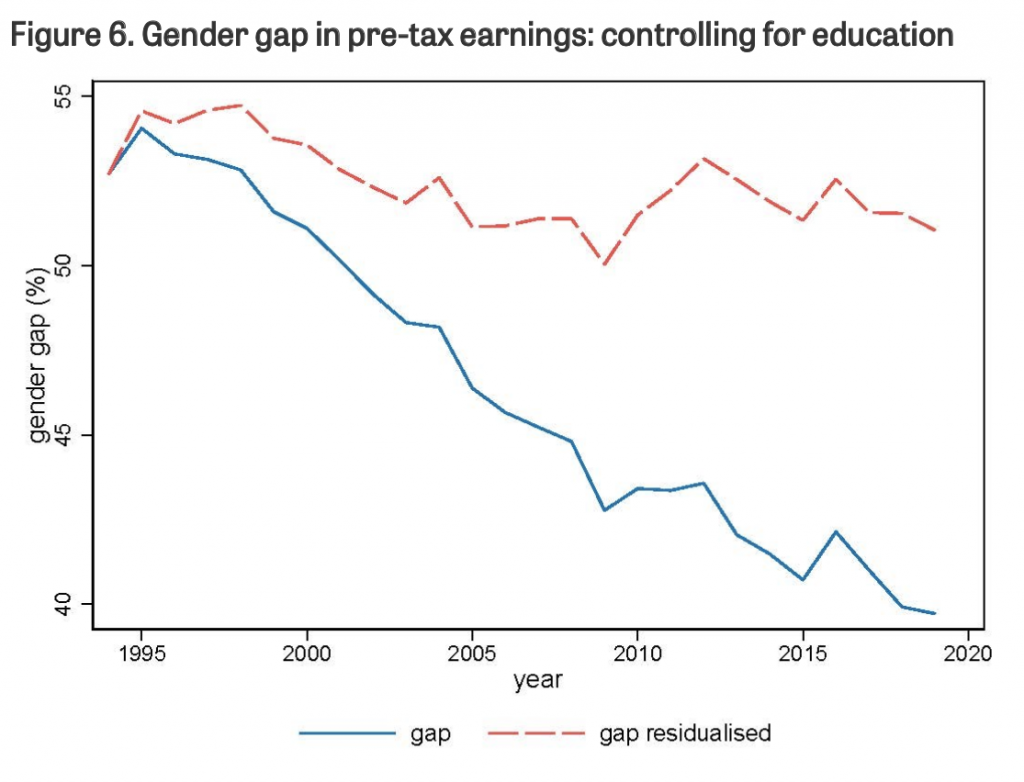It’s sooo slooow: IFS on closing the GPG
The Institute for Fiscal Studies is running a massive study on inequality, funded by the Nuffield Foundation under the guidance of Nobel prizewinner Angus Deaton. The review will run for some time; its scope is admirably ambitious, covering themes such as family, employment, attitudes to inequality, tax, trade and several others. It is already a huge source of policy-relevant information, and promises to be a landmark.
Naturally gender figures widely in the review as a whole, and the latest report, by Alison Andrew and colleagues, deals with gender inequality at work. It is called ‘The more things change the more they stay the same’. The title is suitably wry; it also reminds us that any single trend towards greater equality needs to be matched up with other related trends if its pace and scale are to be properly understood.
The summary picture is clear:
- The earnings gap has closed very slowly over the last quarter century.
- Such closing as has occurred is largely due to women doing much better than men educationally – though the magnitude of the earnings closure does not match the pace of the educational crossover.
- The educational crossover has not been accompanied by other changes – cultural, managerial etc- which should have seen a much bigger result on the earnings gap.
Tracing real weekly earnings over the last quarter century the authors summarise the position quite simply:
The gap is large and slow moving. Men earned just over twice as much as women in the 1990s and just under twice as much 25 years later.
They note that the gap in education attainment closed completely in the 2000s, and adult women under 55 are now more educated than men in the same cohorts. I find their figures on the educational crossover a little hard to understand – they seem to me to date it rather late – but no matter. The combined result is shown in the chart below.

Source: Alison Andrew et al, IFS 2021
The blue line shows the actual shrinking of the earnings gap. (The angle of the decline gives a slightly steeper impression than may be warranted – it’s only from under 55% to around 40% in 25 years). The more or less horizontal trajectory of the red line shows that without the educational progress made by women there would have been hardly any progress.
So education has certainly made a contribution to the narrowing of the pay gap. Without it there would have been precious little movement. However, the report seems me to underplay its basic message of change-but-no-change, given the extent to which women have outstripped men in acquiring qualifications and competences. The ongoing increase in the female/male competence gap is of course the main dynamic behind the Paula Principle.
The report makes very clear the impact that having children has on women’s earnings, and the authors rightly spend a lot of time on issues around childcare and parental leave. Inequalities within and between households are analysed in detail. It spends a lot less time – in fact hardly any, as far as I could see – on inequalities later in life. Since pay gaps are widest for older age groups, and as already observed the educational crossover has already occurred for those aged 55, this is a pity.
However two accompanying papers do add in a longer life perspective. In a punchy accompanying paper on gendered inequalities Fran Bennett locates the debate in the wider context of social policy, dealing with the dizzying complexities of the interactions between pay and benefits. She observes that the earnings debate has to be seen in a full life course context, including life after work. Amen to that. Fran also rightly suggests that symmetry is not necessarily the answer :
It is often assumed that, for couples, gender equality would mean that both partners (especially female/male) would share unpaid and paid work 50/50. But a capability approach would instead suggest creating real freedom in practice for women and men to decide how to share these tasks.
I completely agree. The capability approach opens the way to thinking about equality over the life course, without requiring symmetry at each stage. With longer working lives this means that women and men can all benefit from a greater variety of career models and structures. This in turn should – should – make it easier for women’s competences to be better recognised and rewarded.
Finally, a paper by Claudia Goldin, Sari Pekkala Kerr and Claudia Olivetti with the striking title of The other side of the mountain reports on older women’s earning patterns. (My previous post was on Goldin’s recent work.) They look at the careers of women in the US whose children are no longer young:
We think of this as the ‘other side of the mountain’, when the hard work and great joys of raising the family are over and women can race down the other side and make up for lost time in their careers. Or is this more like a marathon for which stopping at mile 10 puts you behind for ever?
It’s a nice use of imagery. They conclude:
… women work more hours and transition to higher-earning positions. The motherhood penalty is greatly reduced, and by their 50s women with and without children earn nearly the same amount. But fathers manage to maintain their relative gains and do monumentally better than mothers, women without children and men without children.
I haven’t done the papers justice. I simply wanted to applaud the analysis, and yet to argue that the authors of the main paper maybe haven’t captured the full dynamic of the educational crossover and increasing female/male competence gap; and to stress again that we need more attention to the older parts of the working life.
